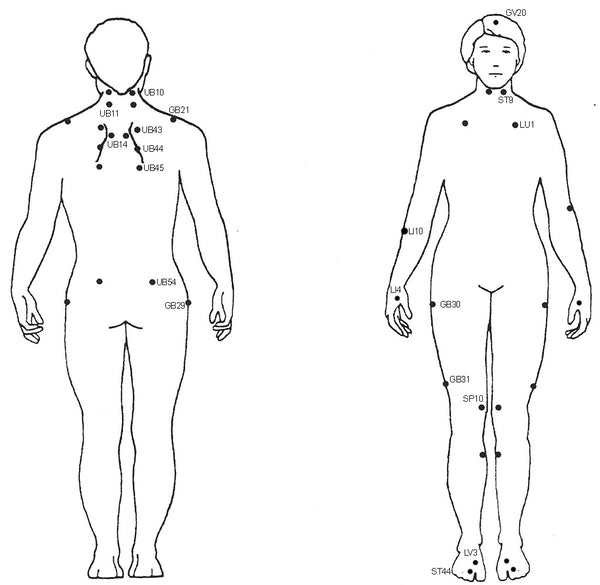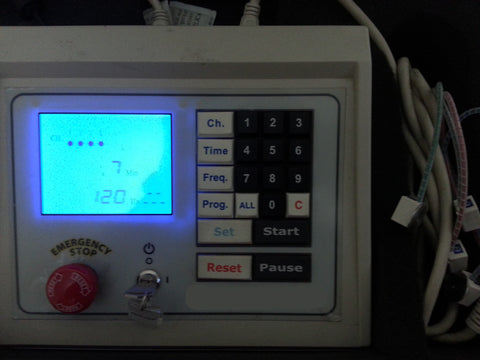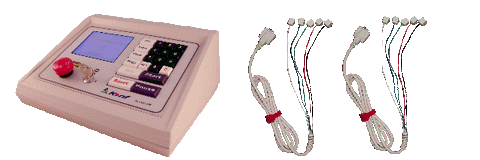Low Level Laser Therapy treatment protocol for Fibromyalgia
Posted by Feroz Osman-Latib on
Fibromyalgia is an ill-understood rheumatic disease causing a wide variety of symptoms that vary greatly from patient to patient. Wide-spread, deep burning pain is perhaps the most frequent symptom. Fibromyalgia pain occurs more commonly in the trunk, low back, hips, and shoulders. It is rare in the hands and feet. Onset is usually gradual and can interfere with even simple daily activities. It is more common in women and also has a stron association with mental stress and depression.
Additional symptoms associated with fibromyalgia include fatigue, sleep disturbances, morning stiffness, headaches, irritable bowel-like symptoms, memory problems, anxiety and depression. Fibromyalgia can also present with flu-like symptoms such as body aches, fatigue and digestive changes. Joint and muscle pain may increase at night, waking the patient from sleep as well as morning stiffness and soreness. Symptoms tend to be episodic and can last from days to months or years.
This article is meant as a guide both for practitioners using laser therapy in their practice or patients with fibromyalgia who want to adopt the use of laser therapy in their homes. The laser equipment used in this article is available to purchase from Aconite Medical for both practitioner and public use. Please be aware that lasers must be used cautiously and within the guidelines as set out below, with special care taken to avoid directing the laser beam into the eye.
(While low power home use lasers can be used with these guidelines, we have found that their effectiveness in the clinic is limited because the frequency paramaters cannot be adjusted and they need to be used for a longer period to deliver the required dosage. For patients using it in the home setting they are ideal as a primary treatment or as maintenance.)
Research
Low Level Laser therapy has shown positive results in a number of resarch studies for the non-drug non-invasive treatment of fibromyalgia and is a viable option that has long term positive benefits without any risk of side-effects when done correctly. For example:
A study at Osmangazi university showed that laser therapy was more effective than placebo for fibromyalgia and the results were sustained long term: http://iospress.metapress.com/content/e4ct023kvnhaefr0/
Another study published in the journal Lasers concluded that laser therapy is effective for pain, muscle spasm, morning stiffness, and total tender point number in fibromyalgia: http://www.ncbi.nlm.nih.gov/pubmed/11845369
Many other studies like this confirm the benefits of Laser therapy, other studies also show that the use of acupuncture is effective for fibromyalgia and for this reason laser therapy is often done at acupuncture points without the need for using needles.
There are several extraordinary effects that have been observed with therapeutic lasers, and phototherapy in general, that make laser therapy unique among the various healing modalities available today. Photobiomodulation produces changes in oxidation/reduction status of the mitochondria which lead to dramatic increases in ATP synthesis. Activation of the sodium/potassium pump alters the cell membrane permeability to calcium. This in turn has many pain relieving and cell regenerating effects.
Initial considerations
When using laser there are 3 main aspects to consider, these are wavelength, frequency and dosage.
Wavelength
The ideal wavelength for musculoskeletal conditions is 660nm and this is the most commonly used for all pain syndromes. In fibromyalgia however we prefer to use 780nm if possible as this wavelength has a deeper penetration depth than 660nm and an enhanced effect on nerve function. (If you are using a unit that is 660nm wavelength this will still work and be more effective than drug therapy.)
Frequency
While there is no definitive research that shows one frequency is better than another for the treatment of fibromyalgia, the research does support the use of varying freqeuncy rates in order to prevent accommodation to the laser stimulation. Anecdotal evidence suggests the following frequencies to be beneficial for fibromyalgia:
120
140
304
464
728
800
880
(These frequencies are varied with each laser session or a maximum of 2 settings can be used in the same session.)
Note that not all laser units allow the frequency to be changed, for this article we will focus on the use of the 10 lead low level laser machine for clinic use pictured below as it is the ideal unit for treating fibromyalgia with LLLT. One could also use a unit with a 5 leads or a single laser probe, the only difference being that the entire session will take a longer time.
Dosage
Dosage is the most important factor determining treatment outcomes. It is measured in Joules and dependant on the power of the laser unit that is being used. A higher power unit will require less time to deliver the recommended dosage, while a lower power unit will require a longer time for the same dosage. Since the treatment of fibromyalgia involves the use of the laser on multiple tender and acupuncture/trigger points, the use of multi-lead unit that can deliver the required to multiple sites at the same time is efficacious. Irrespective of the unit being used however, we recommend that the least amount of time per point that the laser should be used is 5 minutes.
Most laser units will be in the region of 50mW to 80mW power rating per laser diode and therefore we ill use this as the standard in this article for dosage and treatment times.
Remember that we always use lower dosages if it is the first time the patient is having laser. We then increase the dosage at every subsequent session until we reach the recommended dosages. The ideal therapeutic dose is within 50% of the recommended dosages given in this article and you should therefore gauge the patients response to treatment and adjust accordingly.
Using the above unit the aim is to achieve 15 minutes of laser per treatment point/site. In the first visit we do not want to exceed 100J of laser energy delivered if this is the first time the patient is having laser therapy. This means that only 2 points should be used with laser for 15 minutes each or a combination of 4 point can be used for 7.5 minutes each. At subsequent follow up sessions this dosage can be doubled each time either by adding more points or increasing the time. While this is variable depending on the tender points and specific symptoms of each patient we do present a treatment schedule further below.
Treatment sites/points
The sites to be treated consist of 2 categories, tender points and acupuncture/trigger points. Sometimes these overlap and when they do the point should be considered an essential site to be lasered. You will not be able to treat all these points with laser in a single setting, especially in the initial sessions since the dosage will be too high and can produce adverse effects. Points should be selected based on the dosage that you want to deliver.
The acupuncture/trigger points to be considered for use are as per the following diagram:

Treatment schedule
This treatment schedule serves as a guideline, the practitioner can vary points used as well as duration based on the specific symptoms and also response to therapy. The schedule is based on the use of a 50 or 80mW laser diode with multiple leads. It can also be used with a home use machine We recommend laser therapy twice a week for 10 weeks as one course of treatment.
Initial session:
Choose the 2 most tender points on the back of the body in addition to Liver 3 bilaterally (On the dorsum of the foot, in the depression proximal to the 1st metatarsal space.) for a total of 4 points to be treated.
Apply the laser unit for 7 minutes at a frequency setting of 120

You can do traditional acupuncture or dry needling at 8 to 12 other points and also combine with other therapies.
First follow up session:
Select 2 of the most tender points on the front of the body in addition to Liver 3 and LI4 bilaterally for a total of 6 points, apply laser for 10 minutes at a frequency setting of 140.
Second follow up session:
Select GB21, UB10, UB11 and UB43 in addition to 2 tender points on the back of the body for a total of 10 points. Apply laser for 10 minutes at a frequency setting of 304.
Third follow up session (front)
Select GB30, GB31, SP10, SP9 and Liver 3, apply laser for 15 minutes at a frequency setting of 464.
Fourth follow up session (back):
Select UB54, GB29, UB14, UB43, GB21, apply laser for 15 minutes at a frequency setting of 728.
Fifth follow up session (full back treatment)
Select UB54, GB29, UB43, GB21, plus 2 tender points apply laser for 15 minutes at a frequency setting of 800, then do UB 10, UB11, UB14, plus 4 tender points for 15 minutes at a frequency setting of 880
Sixth follow up session (full front treatment)
Select GB30, GB31, SP10, SP9 and Liver 3, apply laser for 15 minutes at a frequency setting of 120. Then select 10 tender points and apply laser at a frequency of 140 for 15 minutes
Seventh follow up session (full back treatment)
Select UB54, GB29, UB43, GB21, plus 2 tender points apply laser for 15 minutes at a frequency setting of 464, then do UB 10, UB11, UB14, plus 4 tender points for 15 minutes at a frequency setting of 728
Eigth follow up session (full front treatment)
Select GB30, GB31, SP10, SP9 and Liver 3, apply laser for 15 minutes at a frequency setting of 800. Then select 10 tender points and apply laser at a frequency of 880 for 15 minutes
Ninth follow up session (full back treatment)
Select UB54, GB29, UB43, GB21, plus 2 tender points apply laser for 15 minutes at a frequency setting of 120, then do UB 10, UB11, UB14, plus 4 tender points for 15 minutes at a frequency setting of 140
Tenth follow up session (full front treatment)
Select GB30, GB31, SP10, SP9 and Liver 3, apply laser for 15 minutes at a frequency setting of 464. Then select 10 tender points and apply laser at a frequency of 728 for 15 minutes
Additional notes:
- One can also use ear points that correspond to the regions affected. With a standard auricular laser device of 50mW power, 20 seconds is sufficient per ear point
- The best guide to treatment is the response of the patient. Record all treatment parameters each session and if a particular frequency or set of points resulted in the best results then adjust the schedule to use those same points/frequencies in the next session
- Fibromyalgia has a strong correlation with qi stagnation patterns in Chinese Medicine, formulae such as Xao Yao San can be used for this.
- If using a home use laser that does not have a frequency setting, ignore those settings but maintain the dosage time recommendations. Treatment can also be done every second day in this case.
Any questions about this protocol? Feel free to email me at info@drlatib.com
If you wish to enquire about laser machines kindly call on the numbers above or email info@aconitemedical.com


